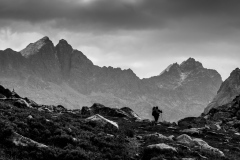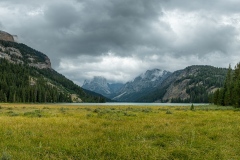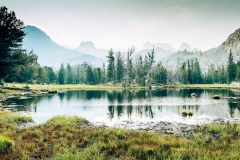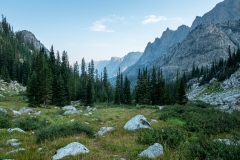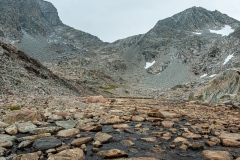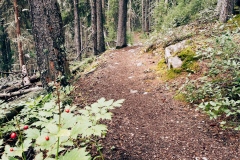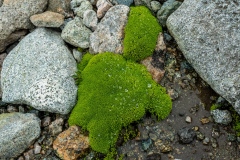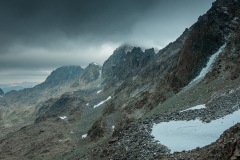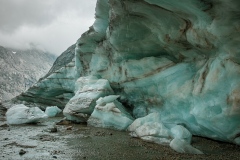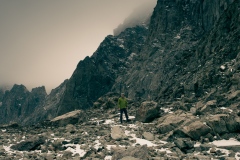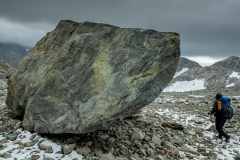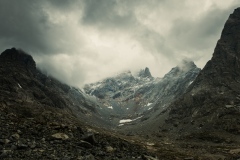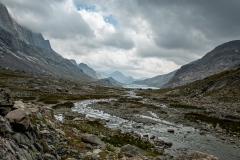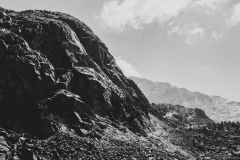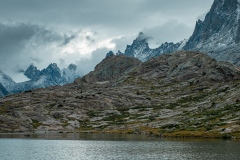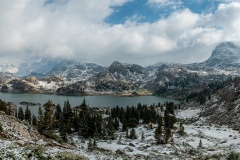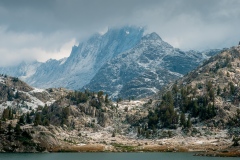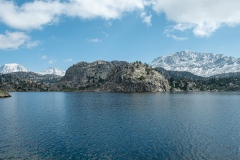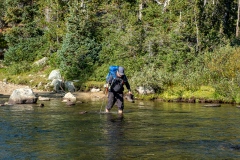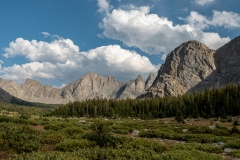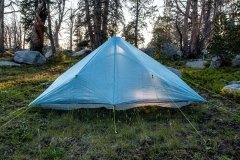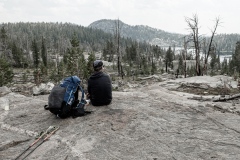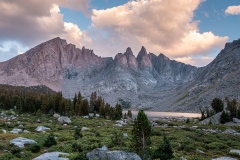A friend asked me to join him on a “bucket list” item — to backpack a high route through the Wind River Range, from North to South. We’ve been planning and preparing all summer and completed the trek in the latter part of August. Here’s my unusually verbose description:
Day 1 (Friday)
Our caravan left Logan at 5 AM, with two vehicles to allow for a shuttle arrangement between our start and ending trailheads. Driving 4.5 hours to the “Big Sandy” trailhead we left my truck at the busy trailhead with keys stashed under the frame, and then drove another 3 hours around to the northern Green River Lakes trailhead. As far as I’m concerned, the shuttle mechanism is the least enjoyable part of a trek like the Wind River High Route. Amazing that it takes three hours of driving to circle around a route that comprises less than 100 miles of hiking, or even less if you take the quickest trail. We’re not planning to take the quickest trail, but instead have planned a route that takes us over many high passes along the backbone of the range – the “Wind River High Route”.
At the trailhead we unload, snap a picture, and hike up the broad canyon, while our intrepid shuttle volunteer starts home on the 5-hour drive back to Logan. The first day’s hike was largely at lower elevation (8k ft) though the wooded Green River Lakes valley. After about 12 miles as we approach the south end of the valley, we take a trail switchbacking up to a hanging valley and find a camp about 10k ft elevation in a pine forest. My partner and I each brought lightweight one-man tents but are sharing the means to heat water for food (he is carrying a single stove). My specialty burden is a 3-lb camera, carried conveniently in a waterproof pack attached to the backpack straps across my chest. My pack is starting out at 30 lbs, with 12 of that comprising my food for seven days.
Today’s distance is 15.6 miles, moving for 6 hours, with 2400 ft ascent and 800 ft descent.

Day 2 (Saturday)
Our morning plan is to wake up at 6 and break camp, leaving by around 7. Today we hike over two minor passes (Vista Pass and Cube Rock Pass) before taking a break for breakfast (oatmeal) at Peak Lake. Wrapping around the lake the trail ended and we find a fading path taking us up towards the Knapsack Col, our high pass for the day at 12.3k ft. This was where the trip starts to feel like a serious endeavor. On these high passes I think the major reason there are no trails are because it is hard to imagine what a trail would actually look like, through a talus field of boulders ranging from feet to tens of feet in size. Carrying packs we must be extra careful to ensure we have good footing as we hop from boulder to boulder, looking for the occasionally flat spot for a quicker pace. The best sections are “green” with just enough soil to support plant life, allowing us to ascend with fewer boulder obstacles.
There is some snow on the pass and a glacier to traverse on the way down the east side of the pass. The outlet of the glacier stream is particularly photogenic and we stop to explore. Heading further down the glacial moraine, we enter the Titcomb Basin, passing by a collection of lakes in a beautiful setting. However the mostly cloudy sky finally turns to rain, then heavy rain and hail, and we shelter behind a rock while the worst of it passed. Continuing our trail in the rain we turn east toward Indian Pass and find a camp site where the valley narrows, setting up our tents at 5:30 just ahead of a major storm. Hunkering down early for the night we experience nearly constant lighting accompanied by rain, heavy rain, hail, sleet, and snow through the night. I set an alarm for every 30 minutes to knock snow off the sides of my 15-ounce tent, but sleep was difficult to find with the lightning and near-immediate thunder.
Today’s distance is 12.6 miles, moving for 8 hours, with 3200 ft ascent and 2200 ft descent.

Day 3 (Sunday)
With little sleep in the night we leave our tents later than usual and find a field of snow perhaps 3-4 inches deep in our campsite. Knowing that the sleet/hail/rain that we experienced for most of the night is probably deep snow in the pass above, we decide to reroute to a lower elevation for the day. We broke a (wet) camp and hike west to the Continental Divide / Highline trail, which avoids the high passes and averages 10.5k ft of elevation for most of its length through the range. The thousand feet of elevation makes a huge difference and we are able to move quickly, covering a total of 15.7 miles on what is still a pretty low-key day.
Mid-day we find a huge rock in the sun and spread out our gear to dry, taking an hour to refuel and rest. We meet more people on this trail as it seems to be far more popular than the higher elevation climes. Late in the day as we are passing by the Chain Lakes, we turn east again on the Bell Lakes Trail to start the climb back to the high route. Setting up camp we eat dinner, hang our bear bags, and retire by 9 when the sun does.
Today’s distance is 16.2 miles, moving for 8 hours, with 1900 ft ascent and 2100 ft descent.

Day 4 (Monday)
Back on a regular schedule and with cooperative weather, we are excited for the day. Our first pass is Hat Pass at a relatively low 11k ft, followed by varied terrain as we climb towards the backbone of the range. Some river crossings are large enough that there is no rock path across and we have to remove shoes, putting on sandals, to wade through the glacial water (cold!). My partner and I both hike with hiking poles, which make most river crossings a lot easier. Stopping for a mid-day break we witness a bald eagle soaring overhead which is a fun bonus. So far we’ve seen very little sign of wildlife.
My dinner meals for this trip are all freeze-dried from home in our new freezer, made from pre-prepared food (mostly leftovers). This night I had “Hawaiian Haystacks” which my wife and I experimented with about a month ago. Breakfast is largely bars of some sort, sometimes with a mid-morning stop to make some instant oatmeal. Lunch is mostly “grazing” food consumed throughout the day, stopping some days to heat water to make a mini-freeze-dried meal for extra calories. I had planned for ~3000 calories per day, but am finding that I eat a bit less.
We are pretty exhausted by the time we arrive at Middle Fork Lake, and it takes a bit to find a camp site about 200’ above the lake shore. On a water-excursion to the Lake, I meet another pair of hikers who are attempting a high route, but at a much more leisurely pace of 7 miles per day. They are a father-and-son group from Kansas and it was nice to visit, since they had just come over the huge set of passes that we were about to climb. I set up my tent right on the edge of a minor cliff, overlooking the lake and the high mountains surrounding it.
Today’s distance is 18.8 miles, moving for 9 hours, with 2900 ft ascent and 2400 ft descent.

Day 5 (Tuesday)
Today is my birthday and I can’t imagine a nicer way to wake up than on a beautiful day in the Wind River Range, camped on a cliff overlooking a lake! We beak camp and are hiking by 7 AM, a little nervous about the path ahead. But we shouldn’t have worried. The first pass is incredible, with many stops for photos of the high peaks as we climbed. This route is pretty-much all off-trail, and so we stop periodically and scout possible routes up through the tundra/talus slope as the elevation steepens. Heading down the backside of the Bonneville/Lee saddle, we have to route-find as we descend a series of ledges on the way to the lake.
At the lake we have lunch and prepare for the ascent over the Bonneville/Raid pass , while scouting a more difficult but shorter route. My partner leads as we climb through some challenging class 4 terrain with loose rock and flowing water. Gaining the saddle we finish the pass and drop down the other side through a heavy talus field. From there we get separated and he ends up getting cliffed out and needed to find another route down. We reconnect an hour later at the head of the valley and continue off-trail towards Pyramid Lake, where we stop for a late lunch and a recharge.
Heading down canyon we turn east at a major intersection and hike up towards Texas Pass and the Cirque of the Towers. Finding a great campsite we watch the sunset on the peaks before heading to bed for our last night in the Winds. I share some of my “Spam and Mashed Potatoes” meal saved for my birthday.
Today’s distance is 15.6 miles, moving for 8 hours, with 2700 ft ascent and 2400 ft descent.

Day 6 (Wednesday)
Waking on the last day in the range, we break camp and make our way towards Texas Pass and up over into the Cirque of the Towers. By now my pack has dropped 9 lbs in food weight so it seems easier to climb, but there is definitely some accumulated fatigue to offset! We stop on the pass to take pictures and refill water at a spring. The Cirque has always captivated me, since hiking there a decade ago with my 10-year-old son, but now I realize the north/backside gives the better views.
My partner is teaching me about multi-pitch “trad” climbing as we hike past Pingora where two teams of climbers are mid-way to the summit. We can hear their calls of “Off Belay” breaking the silence from far above us. Continuing south over the final pass, we descend to Big Sandy Lake and turn west towards the trailhead. Through the final six miles of hiking we’re reminded how big of a wind storm the region experience last fall when huge numbers of mature trees were brought down in one afternoon. The trail is now cleared but the debris is amazing.
At the trailhead I retrieve the keys and we load up for the drive home. Stopping for ice cream on the first town we pass, we make it home by 7 PM, roughly two days ahead of our full schedule.
Today’s distance is 14.3 miles, moving for 7 hours, with 2000 ft ascent and 3200 ft descent.

TOTAL distance 93.1 miles, 46 hours, 15100 ft ascent, 13100 ft descent
Resources:
- The Wind River Range is fairly remote, with long gravel roads to reach the widely-spaced trailheads. Expect some time to travel in and out.
- Plenty of primitive camping available at the trailheads.
- Hiking tracks are available online from various sources, but I recommend you tailor the tracks to suit your interests rather than blindly following someone else’s track. The Winds are varied in terrain and elevation, and there are plenty of options as you plan each section of your own high route!
Lessons Learned
- I used a spreadsheet to manage my gear planning, including each weighed item and where I would place it in my pack.
- Fundamentally I used a podded organization method, with the following four sections in my backpack:
- Sleeping bag
- Campsite system (everything else I need for camp at night, but not during the day)
- Clothing system (storm clothing)
- Cook & Hygiene System (everything needed to prepare/eat food, along with toiletries and medicine)

